UC Berkeley Press Release
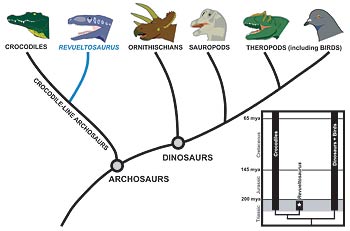 |
The evolutionary tree of dinosaurs and crocodiles, showing that Revueltosaurus is not an ornithischian dinosaur, but a dead-end offshoot of the line leading to crocodiles. (Graphic by Randall Irmis / Andrew Lee / Nick Pyenson) Click here for larger version |
Revueltosaurus skeleton unearthed at Petrified Forest upsets dinosaur tale
BERKELEY – The fossilized skeleton of a small crocodile relative excavated last year at Petrified Forest National Park in Arizona throws a wrench into theories of how and where the dinosaurs arose more than 210 million years ago at the end of the Triassic Period.
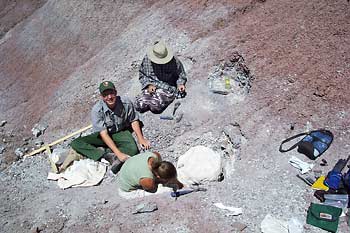 Revueltosaurus quarry excavation, June 2004. Clockwise from left: Randall Irmis, Jeff Martz and Lori Browne. (National Park Service photo) |
The animal, one of many creatures from the Late Triassic known only from their teeth, was thought to be an ancestor of the plant-eating ornithischian dinosaurs like Stegosaurus and Triceratops, which roamed the world millions of years later in the Jurassic and Cretaceous periods.
The fact that this presumed dinosaur, Revueltosaurus callenderi, is instead a crocodile ancestor does not merely disappoint rockhounds, who sell the abundant teeth as "dinosaur teeth," but it also throws into question the identity of other presumed dinosaur ancestors known only from teeth, which includes all Late Triassic ornithischians outside South America.
"Because the teeth look like those we know from herbivorous ornithischians, people assigned them to the dinosaurs," said Randall Irmis, a graduate student in the Department of Integrative Biology and the Museum of Paleontology at UC Berkeley. "We think we've shown that you can't rely on the dentition to determine what is an early dinosaur, which casts doubt on all the ornithischians from the Triassic of North America."
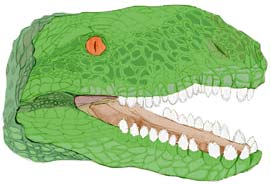 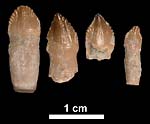 Reconstruction of the head and photo of the herbivorous teeth of Revueltosaurus callenderi. (Top: Gautam Rangan; right: Randall Irmis/NPS) Reconstruction of the head and photo of the herbivorous teeth of Revueltosaurus callenderi. (Top: Gautam Rangan; right: Randall Irmis/NPS) |
This suggests, he said, that the herbivorous ornithischians and the meat-eating theropods, like Tyrannosaurus rex, did not evolve together in the Late Triassic as many paleontologists thought. Rather, the theropods were well established worldwide before the ornithischians spread out into North America, Europe and Africa at the very end of the Triassic, perhaps from possible origins in South America.
"We have pretty much erased the record of Triassic ornithischian dinosaurs from North America, Europe and worldwide, except for South America," said the fossil's discoverer, park paleontologist William Parker. "Even the fossils in South America aren't very well preserved, and people argue whether they're dinosaurian as well. If the South American animals are indeed ornithischians, then it argues that the group possibly arose there."
Parker, Irmis and their colleagues - graduate student Sterling J. Nesbitt of the Lamont-Doherty Earth Observatory at Columbia University in New York, graduate student Jeffrey W. Martz of Texas Tech University in Lubbock, and Lori S. Browne of the South Dakota School of Mines and Technology in Rapid City - reported their find in the May issue of the journal Proceedings of the Royal Society, Biological Sciences.
Dinosaurs are divided into two main groups, the ornithischians and saurischians, both of which, based on fossil finds, appeared to arise in the Late Triassic, between 225 and 200 million years ago. The early ornithischians were thought to have evolved into animals such as the stegosaurs of the Jurassic and the frilled and duck-billed dinosaurs of the Cretaceous, while the saurischians split into the sauropodomorphs - the long-necked browsers like Brachiosaurus - and the carnivorous theropods, like T. rex. Only the theropods survive to the present as birds.
If, as the team concludes, the first ornithischians outside South America did not appear until 25 million years later than people thought, the picture of dinosaur evolution radically shifts.
"Basically, you have two groups that were thought to appear at the same time and co-evolve, and now you have one completely wiped away," Parker said. "So where did the ornithischian dinosaurs come from? We don't know right now. That's something we are going to address in the future."
Irmis acknowledges that early ornithischians may have been around, yet were rare and living in places not conducive to the preservation of fossils. But they definitely were not as common and diverse in the Late Triassic as some paleontologists have claimed.
"Sauropodomorphs and theropods are geographically widespread by the end of the Triassic, though the theropods at this time also were small and rare," Irmis said. "What we found suggests that ornithischian dinosaurs did not diversify and get large until the beginning of the Jurassic."
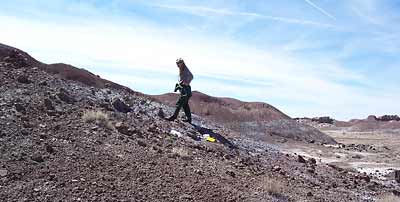 Karen Dorn, chief of the resource management division at Petrified Forest National Park, points with her toe to a Revueltosaurus jawbone with teeth, a key discovery that proved the alleged dinosaur is instead a relative of today's crocodiles. (William Parker, NPS 2004) |
"People have argued that there is a great diversity of dinosaurs in the Late Triassic, and this shows that they are not as diverse as many thought," Parker said. "Diversity is only found among the ancestors of the sauropods and theropods. Exactly how diverse were these other groups? That's something we also want to test."
Revueltosaurus is a relatively recent discovery, having been named only in 1989 from teeth found in Revuelto Creek, New Mexico, by Adrian Hunt. Kevin Padian, professor of integrative biology at UC Berkeley, found and identified Revueltosaurus teeth from Petrified Forest National Park in 1990, though an earlier UC Berkeley paleontologist, Charles Camp, had found but not identified teeth from these creatures in the early 1930s. Unknowingly, Hunt, Padian and Camp had also found other bones of Revueltosaurus, but because these remains were not found with the teeth, the association could not be made.
The newly discovered full skeleton of a Revueltosaurus makes it clear that the teeth are not of a plant-eating dinosaur, but of a herbivorous or perhaps omnivorous crocodilian ancestor living a mostly terrestrial life in the uplands of the Late Triassic. It may have been one source of meat for the developing theropods around the world.
"This find is a great thing for the crocodilian record, too. Here's this totally unrecognized group of possibly herbivorous crocodilians," Parker said. "The convergent evolution of the teeth is what makes them look like herbivorous dinosaurs. That's the only thing similar in the entire skeleton. There are no other dinosaur characters in the entire animal."
Parker picked up the first fossils in March of 2004 at a promising outcrop in an area of the park that evidently had not been scouted by previous paleontologists, many of them from UC Berkeley. The campus has been involved in the park, located in northeastern Arizona near Holbrook, since John Muir first picked up fossil bones and teeth while passing through in 1906 and deposited them with the University of California.
Parker's initial fossil finds were crocodilian-like armor, but he didn't realize they were from Revueltosaurus until the next day, when he brought a colleague to the site and she picked up a jaw with teeth. During May and June of 2004, Parker, Irmis and their coauthors excavated one complete Revueltosaurus skeleton from the 6-square meter quarry they dug, plus bones from more than a dozen other individuals. In June of 2005, a second relatively complete skeleton was uncovered from the same site.
Irmis, who first started working in the park with Parker in 2002 as an undergraduate at Northern Arizona University, said that this crocodilian ancestor was only three to four feet long, with a stubbier, less flattened skull and a less sprawling leg posture than today's crocodiles have. Also, the armor did not cover the entire body, but was restricted to two lines down the back. The creature is most similar, he said, to a group of Triassic archosaurs - the group that includes crocodiles, dinosaurs and birds - called the aetosaurs.
Irmis, Parker and Nesbitt are continuing their look at the alleged ornithischians of the Late Triassic to ascertain the quality of the fossil record and what it says about early dinosaur evolution.
The work was supported by the Recreational Fee Demo Program of Petrified Forest National Park and by the Petrified Forest Museum Association.

